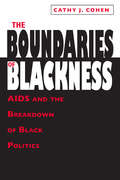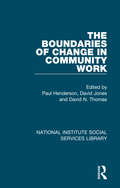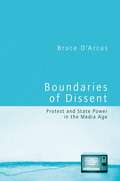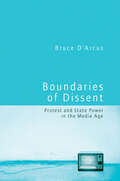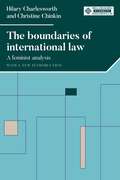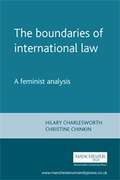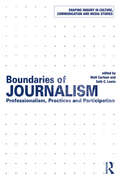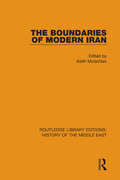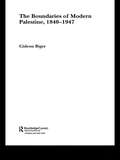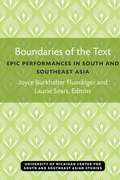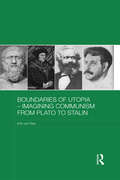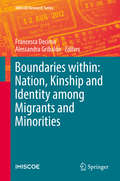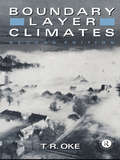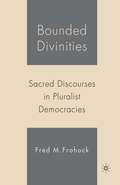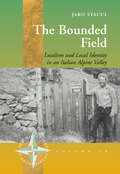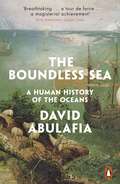- Table View
- List View
The Boundaries of Blackness: AIDS and the Breakdown of Black Politics
by Cathy J. CohenLast year, more African Americans were reported with AIDS than any other racial or ethnic group. And while African Americans make up only 13 percent of the U.S. population, they account for more than 55 percent of all newly diagnosed HIV infections. These alarming developments have caused reactions ranging from profound grief to extreme anger in African-American communities, yet the organized political reaction has remained remarkably restrained. The Boundaries of Blackness is the first full-scale exploration of the social, political, and cultural impact of AIDS on the African-American community. Informed by interviews with activists, ministers, public officials, and people with AIDS, Cathy Cohen unflinchingly brings to light how the epidemic fractured, rather than united, the black community. She traces how the disease separated blacks along different fault lines and analyzes the ensuing struggles and debates. More broadly, Cohen analyzes how other cross-cutting issues—of class, gender, and sexuality—challenge accepted ideas of who belongs in the community. Such issues, she predicts, will increasingly occupy the political agendas of black organizations and institutions and can lead to either greater inclusiveness or further divisiveness. The Boundaries of Blackness, by examining the response of a changing community to an issue laced with stigma, has much to teach us about oppression, resistance, and marginalization. It also offers valuable insight into how the politics of the African-American community—and other marginal groups—will evolve in the twenty-first century.
The Boundaries of Blackness: AIDS and the Breakdown of Black Politics
by Cathy J. CohenLast year, more African Americans were reported with AIDS than any other racial or ethnic group. And while African Americans make up only 13 percent of the U.S. population, they account for more than 55 percent of all newly diagnosed HIV infections. These alarming developments have caused reactions ranging from profound grief to extreme anger in African-American communities, yet the organized political reaction has remained remarkably restrained. The Boundaries of Blackness is the first full-scale exploration of the social, political, and cultural impact of AIDS on the African-American community. Informed by interviews with activists, ministers, public officials, and people with AIDS, Cathy Cohen unflinchingly brings to light how the epidemic fractured, rather than united, the black community. She traces how the disease separated blacks along different fault lines and analyzes the ensuing struggles and debates. More broadly, Cohen analyzes how other cross-cutting issues—of class, gender, and sexuality—challenge accepted ideas of who belongs in the community. Such issues, she predicts, will increasingly occupy the political agendas of black organizations and institutions and can lead to either greater inclusiveness or further divisiveness. The Boundaries of Blackness, by examining the response of a changing community to an issue laced with stigma, has much to teach us about oppression, resistance, and marginalization. It also offers valuable insight into how the politics of the African-American community—and other marginal groups—will evolve in the twenty-first century.
The Boundaries of Blackness: AIDS and the Breakdown of Black Politics
by Cathy J. CohenLast year, more African Americans were reported with AIDS than any other racial or ethnic group. And while African Americans make up only 13 percent of the U.S. population, they account for more than 55 percent of all newly diagnosed HIV infections. These alarming developments have caused reactions ranging from profound grief to extreme anger in African-American communities, yet the organized political reaction has remained remarkably restrained. The Boundaries of Blackness is the first full-scale exploration of the social, political, and cultural impact of AIDS on the African-American community. Informed by interviews with activists, ministers, public officials, and people with AIDS, Cathy Cohen unflinchingly brings to light how the epidemic fractured, rather than united, the black community. She traces how the disease separated blacks along different fault lines and analyzes the ensuing struggles and debates. More broadly, Cohen analyzes how other cross-cutting issues—of class, gender, and sexuality—challenge accepted ideas of who belongs in the community. Such issues, she predicts, will increasingly occupy the political agendas of black organizations and institutions and can lead to either greater inclusiveness or further divisiveness. The Boundaries of Blackness, by examining the response of a changing community to an issue laced with stigma, has much to teach us about oppression, resistance, and marginalization. It also offers valuable insight into how the politics of the African-American community—and other marginal groups—will evolve in the twenty-first century.
The Boundaries of Change in Community Work (National Institute Social Services Library)
by Paul Henderson David Jones David N. ThomasSince the late 1960s, community work had emerged in its own right as an occupation with an increasingly important contribution to make both to ways of thinking within the field of social policy, and to day-to-day social work practice and the resolution of pressing community issues. Its practitioners had grown in numbers and experience, while community work ideas and methods continued to influence developments in a variety of other ‘neighbouring’ occupations. Originally published in 1980, the editors of this NISW collection suggest that if community workers are to remain effective, then they must stay on the boundaries of the agencies that employ them and of the groups with whom they work. This theme of the ‘boundary nature’ of community work is examined in detail in the Introduction and is subsequently taken up by the other contributors to the book. This title is organised under three main headings – a survey section on the history, philosophy and theories of community work in the United Kingdom; a series of case studies that suggest the diversity of the interests of community work; and an analysis of the growth of community work as an occupation and the spread of its influence through related professions and disciplines. This mix of theory, practice and analysis made the book of special importance both to practising community workers and to community work teachers and students at the time. In addition, the book would have been of direct interest to community oriented administrators, professionals, teachers and students in other human service fields such as health, education, housing, planning and the personal social services, as well as to elected members and administrators in central and local government more generally. It will now be welcomed by anyone who seeks a critical account of the historical activities of community work, written by experienced practitioners and teachers.
The Boundaries of Change in Community Work (National Institute Social Services Library)
by Paul Henderson, David Jones and David N. ThomasSince the late 1960s, community work had emerged in its own right as an occupation with an increasingly important contribution to make both to ways of thinking within the field of social policy, and to day-to-day social work practice and the resolution of pressing community issues. Its practitioners had grown in numbers and experience, while community work ideas and methods continued to influence developments in a variety of other ‘neighbouring’ occupations. Originally published in 1980, the editors of this NISW collection suggest that if community workers are to remain effective, then they must stay on the boundaries of the agencies that employ them and of the groups with whom they work. This theme of the ‘boundary nature’ of community work is examined in detail in the Introduction and is subsequently taken up by the other contributors to the book. This title is organised under three main headings – a survey section on the history, philosophy and theories of community work in the United Kingdom; a series of case studies that suggest the diversity of the interests of community work; and an analysis of the growth of community work as an occupation and the spread of its influence through related professions and disciplines. This mix of theory, practice and analysis made the book of special importance both to practising community workers and to community work teachers and students at the time. In addition, the book would have been of direct interest to community oriented administrators, professionals, teachers and students in other human service fields such as health, education, housing, planning and the personal social services, as well as to elected members and administrators in central and local government more generally. It will now be welcomed by anyone who seeks a critical account of the historical activities of community work, written by experienced practitioners and teachers.
Boundaries of Dissent: Protest and State Power in the Media Age
by Bruce D'ArcusBoundaries of Dissent looks at the way that political protest, as it is shaped through the space-time collapsing power of media, questions national identity and state authority. Through this lens of protest politics, Bruce D'Arcus examines how public and private space is symbolically mediated-the way that power and dissent are articulated in the contemporary media.
Boundaries of Dissent: Protest and State Power in the Media Age
by Bruce D'ArcusBoundaries of Dissent looks at the way that political protest, as it is shaped through the space-time collapsing power of media, questions national identity and state authority. Through this lens of protest politics, Bruce D'Arcus examines how public and private space is symbolically mediated-the way that power and dissent are articulated in the contemporary media.
The boundaries of international law: A feminist analysis, with a new introduction (Melland Schill Classics in International Law)
by Hilary Charlesworth Christine ChinkinIn the first book-length treatment of the application of feminist theories of international law, Charlesworth and Chinkin argue that the absence of women in the development of international law has produced a narrow and inadequate jurisprudence that has legitimated the unequal position of women worldwide rather than confronting it.The boundaries of international law provides a feminist perspective on the structure, processes and substance of international law, shedding new light on treaty law, the concept of statehood and the right of self-determination, the role of international institutions and the law of human rights. Concluding with a consideration of whether the inclusion of women in the jurisdiction of international war crimes tribunals represents a significant shift in the boundaries of international law, the book encourages a dramatic rethinking of the discipline of international law. With a new introduction that reflects on the profound changes in international law since the book’s first publication in 2000, this provocative volume is essential reading for scholars, practitioners and students alike.
The boundaries of international law: A feminist analysis, with a new introduction (Melland Schill Classics in International Law)
by Hilary Charlesworth Christine ChinkinIn the first book-length treatment of the application of feminist theories of international law, Charlesworth and Chinkin argue that the absence of women in the development of international law has produced a narrow and inadequate jurisprudence that has legitimated the unequal position of women worldwide rather than confronting it.The boundaries of international law provides a feminist perspective on the structure, processes and substance of international law, shedding new light on treaty law, the concept of statehood and the right of self-determination, the role of international institutions and the law of human rights. Concluding with a consideration of whether the inclusion of women in the jurisdiction of international war crimes tribunals represents a significant shift in the boundaries of international law, the book encourages a dramatic rethinking of the discipline of international law. With a new introduction that reflects on the profound changes in international law since the book’s first publication in 2000, this provocative volume is essential reading for scholars, practitioners and students alike.
The Boundaries Of International Law: A Feminist Analysis (Melland Schill Studies In International Law Mup Ser.)
by Hilary Charlesworth Christine ChinkinThe first book-length treatment of the application of feminist theories to international law.. Its central argument is that the absence of women in the development of international law has produced a narrow and inadequate jurisprudence that has legitimated the unequal position of women world-wide rather than confronted it.. Provides a feminist perspective on the structure, processes and substance of international law dealing with its sources, treaty law, the concept of statehood and the right of self-determination, the role of international institutions and the law of human rights.. They finally consider whether inclusion of women in the jurisdiction of international war crimes tribunals represents a significant shift in the boundaries of international law.. Aims to encourage a rethinking of the discipline of international law so that it can offer a more useful framework for international and national justice.
Boundaries of Journalism: Professionalism, Practices and Participation (Shaping Inquiry in Culture, Communication and Media Studies)
by Matt Carlson Seth C. LewisThe concept of boundaries has become a central theme in the study of journalism. In recent years, the decline of legacy news organizations and the rise of new interactive media tools have thrust such questions as "what is journalism" and "who is a journalist" into the limelight. Struggles over journalism are often struggles over boundaries. These symbolic contests for control over definition also mark a material struggle over resources. In short: boundaries have consequences. Yet there is a lack of conceptual cohesiveness in what scholars mean by the term "boundaries" or in how we should think about specific boundaries of journalism. This book addresses boundaries head-on by bringing together a global array of authors asking similar questions about boundaries and journalism from a diverse range of perspectives, methodologies, and theoretical backgrounds. Boundaries of Journalism assembles the most current research on this topic in one place, thus providing a touchstone for future research within communication, media and journalism studies on journalism and its boundaries.
Boundaries of Journalism: Professionalism, Practices and Participation (Shaping Inquiry in Culture, Communication and Media Studies)
by Matt Carlson Seth C. LewisThe concept of boundaries has become a central theme in the study of journalism. In recent years, the decline of legacy news organizations and the rise of new interactive media tools have thrust such questions as "what is journalism" and "who is a journalist" into the limelight. Struggles over journalism are often struggles over boundaries. These symbolic contests for control over definition also mark a material struggle over resources. In short: boundaries have consequences. Yet there is a lack of conceptual cohesiveness in what scholars mean by the term "boundaries" or in how we should think about specific boundaries of journalism. This book addresses boundaries head-on by bringing together a global array of authors asking similar questions about boundaries and journalism from a diverse range of perspectives, methodologies, and theoretical backgrounds. Boundaries of Journalism assembles the most current research on this topic in one place, thus providing a touchstone for future research within communication, media and journalism studies on journalism and its boundaries.
The Boundaries of Modern Iran (Routledge Library Editions: History of the Middle East)
by Keith MclachlanThis book, first published in 1994, analyses the entire length of Iran’s international boundaries. It reviews the establishment, evolution and continuing contentions over Iranian frontier zones and boundary lines, from the creation of the Iranian nation state out of the diverse and dispersed areas of the Persian empire – a process that has given rise to many contemporary problems that spill over into dispute and conflict.
The Boundaries of Modern Iran (Routledge Library Editions: History of the Middle East)
by Keith MclachlanThis book, first published in 1994, analyses the entire length of Iran’s international boundaries. It reviews the establishment, evolution and continuing contentions over Iranian frontier zones and boundary lines, from the creation of the Iranian nation state out of the diverse and dispersed areas of the Persian empire – a process that has given rise to many contemporary problems that spill over into dispute and conflict.
The Boundaries of Modern Palestine, 1840-1947 (Routledge Studies in Middle Eastern History)
by Gideon BigerBoundary limitation is a crucial issue in the Middle East, and the boundaries marked out during the years 1840 to 1947 are still one of the major issues in today's political discussions concerning Israel and its surrounding countries.This book, which is based on extensive archival research, deals with the first stage of the delimitation of the boundaries of modern Palestine, between the years 1840 and 1947. During this period, the boundaries of Palestine were staked out by foreign, imperial forces (Britain, France and the Ottoman Empire) which placed them according to their desires, without considering local needs or ideas. For the first time, thanks to the fascinating evidence revealed in archives, this invaluable book reveals the hidden ambitions; the motives of different agents; and the stories of those involved in the process as well as the eventual outcome of their work - the first delimitation of the Holy Land in the modern era.
The Boundaries of Modern Palestine, 1840-1947 (Routledge Studies in Middle Eastern History)
by Gideon BigerBoundary limitation is a crucial issue in the Middle East, and the boundaries marked out during the years 1840 to 1947 are still one of the major issues in today's political discussions concerning Israel and its surrounding countries.This book, which is based on extensive archival research, deals with the first stage of the delimitation of the boundaries of modern Palestine, between the years 1840 and 1947. During this period, the boundaries of Palestine were staked out by foreign, imperial forces (Britain, France and the Ottoman Empire) which placed them according to their desires, without considering local needs or ideas. For the first time, thanks to the fascinating evidence revealed in archives, this invaluable book reveals the hidden ambitions; the motives of different agents; and the stories of those involved in the process as well as the eventual outcome of their work - the first delimitation of the Holy Land in the modern era.
Boundaries of the Text: Epic Performances in South and Southeast Asia (Michigan Papers On South And Southeast Asia #35)
by Joyce Burkhalter Flueckiger Laurie J. SearsWhen the Mahabharata and Ramayana are performed in South and Southeast Asia, audiences may witness a variety of styles. A single performer may deliver a two-hour recitation, women may meet in informal singing groups, shaddow puppets may host an all-night play, or professional theaters may put on productions lasting thirty nights. Performances often celebrate ritual passages: births, deaths, marriages, and religious observances. The stories live and are transmitted through performance; their characters are well known and well loved. Yet written versions of the Mahabharata and Ramayana have existed in both South and Southeast Asia for hundreds of years. Rarely have these texts been intended for private reading. What is the relationship between written text and oral performance? What do performers and audiences mean when they identify something as “Ramayana” or “Mahabharata”? How do they conceive of texts? What are the boundaries of the texts? By analyzing specific performance traditions, Boundaries of the Text addresses questions of what happens to written texts when they are preformed and how performance traditions are affected when they interact with written texts. The dynamics of this interaction are of particular interest in South and Southeast Asia where oral performance and written traditions share a long, interwoven history. The contributors to Boundaries of the Text show the difficulty of maintaining sharp distinctions between oral and written patterns, as the traditions they consider defy a unidirectional movement from oral to written. The boundaries of epic traditions are in a state of flux, contracting or expanding as South and Southeast Asian societies respond to increasing access to modern education, print technology, and electronic media.
Boundaries of Utopia - Imagining Communism from Plato to Stalin (Routledge Contemporary Russia and Eastern Europe Series)
by Erik van ReeThe idea that socialism could be established in a single country was adopted as an official doctrine by the Soviet Union in 1925, Stalin and Bukharin being the main formulators of the policy. Before this there had been much debate as to whether the only way to secure socialism would be as a result of socialist revolution on a much broader scale, across all Europe or wider still. This book traces the development of ideas about communist utopia from Plato onwards, paying particular attention to debates about universalist ideology versus the possibility for "socialism in one country". The book argues that although the prevailing view is that "socialism in one country" was a sharp break from a long tradition that tended to view socialism as only possible if universal, in fact the territorially confined socialist project had long roots, including in the writings of Marx and Engels.
Boundaries of Utopia - Imagining Communism from Plato to Stalin (Routledge Contemporary Russia and Eastern Europe Series)
by Erik van ReeThe idea that socialism could be established in a single country was adopted as an official doctrine by the Soviet Union in 1925, Stalin and Bukharin being the main formulators of the policy. Before this there had been much debate as to whether the only way to secure socialism would be as a result of socialist revolution on a much broader scale, across all Europe or wider still. This book traces the development of ideas about communist utopia from Plato onwards, paying particular attention to debates about universalist ideology versus the possibility for "socialism in one country". The book argues that although the prevailing view is that "socialism in one country" was a sharp break from a long tradition that tended to view socialism as only possible if universal, in fact the territorially confined socialist project had long roots, including in the writings of Marx and Engels.
Boundaries within: Nation, Kinship and Identity among Migrants and Minorities (IMISCOE Research Series)
by Francesca Decimo Alessandra GribaldoThis volume investigates the relationship between migration, identity, kinship and population. It uncovers the institutional practices of categorization as well as the conducts and the ethics adopted by social actors that create divisions between citizens and non-citizens, migrants and their descendants inside national borders. The essays provide multiple empirical analyses that capture the range of politics, debates, regulations, and documents through which the us/them distinction comes to be constructed and reconstructed. At the same time, the authors reveal how this distinction is experienced, reinterpreted, and reproduced by those directly affected by governmental actions. This perspective grants equal attention to both the logics of national governmentality and the myriad ways that individuals and collectivities entangle with categories of identity. Featuring case studies from countries as varied as the Netherlands; French Guiana; South-Tyrol; Eritrea and Ethiopia; New York City; Italy; and Liangshan, China, this book offers unique insights into the production of identity boundaries in the contested terrain of migration and minorities. It outlines how the process of producing national identity is enacted not only through impositions from above, but also when individuals themselves embody and deploy identities and kinship bonds. More so than lines of division, boundaries within are understood as an ongoing process of identity construction and social exclusion taking place among the various actors, levels, and spaces that make up the national fabric.
Boundary Layer Climates
by T. R. OkeThis modern climatology textbook explains those climates formed near the ground in terms of the cycling of energy and mass through systems.
Boundary Layer Climates
by T. R. OkeThis modern climatology textbook explains those climates formed near the ground in terms of the cycling of energy and mass through systems.
Bounded Divinities: Sacred Discourses in Pluralist Democracies
by F. FrohockThis serves as a handbook to guide us through the thickets of the sacred, the secular, religion and politics, by charting the supernatural as a natural defining feature of religion. Santería is used as a case study to illustrate the similarities and differences among religious and political practices and discusses effective dispute management.
The Bounded Field: Localism and Local Identity in an Italian Alpine Valley (New Directions in Anthropology #18)
by Jaro StaculRegionalism is one of the most debated issues in contemporary western Europe. Yet why the region, rather than the nation state, can have such a strong appeal for the construction of social and political identity remains largely unexplored. Drawing on data collected in the mountainous Trentino region of northern Italy, the author investigates how ideas about village boundaries and private property form the background against which regionalist ideologies are understood. In suggesting that ideas about regionalism largely reflect views about private property, he provides an alternative to theories of nationalism that overlook the articulation between official ideologies and discourses at the local level.
The Boundless Sea: A Human History of the Oceans
by David AbulafiaFrom the award-winning author of The Great Sea, a magnificent new global history of the oceans and of humankind's relationship with the sea For most of human history, the seas and oceans have been the main means of long-distance trade and communication between peoples - for the spread of ideas and religion as well as commerce. This book traces the history of human movement and interaction around and across the world's greatest bodies of water, charting our relationship with the oceans from the time of the first voyagers. David Abulafia begins with the earliest of seafaring societies - the Polynesians of the Pacific, the possessors of intuitive navigational skills long before the invention of the compass, who by the first century were trading between their far-flung islands. By the seventh century, trading routes stretched from the coasts of Arabia and Africa to southern China and Japan, bringing together the Indian Ocean and the western Pacific and linking half the world through the international spice trade. In the Atlantic, centuries before the little kingdom of Portugal carved out its powerful, seaborne empire, many peoples sought new lands across the sea - the Bretons, the Frisians and, most notably, the Vikings, now known to be the first Europeans to reach North America. As Portuguese supremacy dwindled in the late sixteenth century, the Spanish, the Dutch and then the British each successively ruled the waves.Following merchants, explorers, pirates, cartographers and travellers in their quests for spices, gold, ivory, slaves, lands for settlement and knowledge of what lay beyond, Abulafia has created an extraordinary narrative of humanity and the oceans. From the earliest forays of peoples in hand-hewn canoes through uncharted waters to the routes now taken daily by supertankers in their thousands, The Boundless Sea shows how maritime networks came to form a continuum of interaction and interconnection across the globe: 90 per cent of global trade is still conducted by sea. This is history of the grandest scale and scope, and from a bracingly different perspective - not, as in most global histories, from the land, but from the boundless seas.
